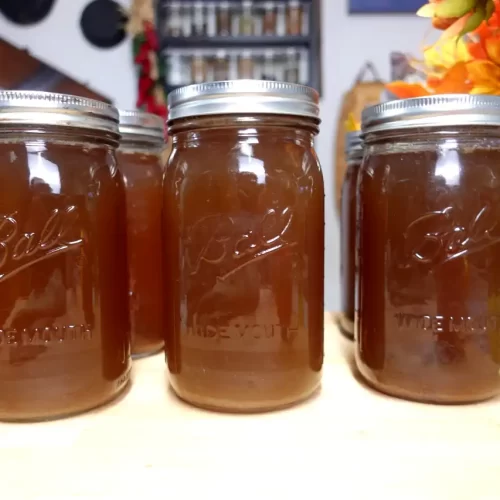
Homemade Beef Broth
This homemade beef broth is slow-simmered in an 18-quart electric roaster for deep, rich flavor. Made with roasted beef bones, onions, carrots, celery, garlic, and herbs, it’s perfect for freezing or pressure canning. A nourishing staple to use in soups, stews, gravies, and more!
Equipment
- canning jars optional
Ingredients
- 10 lbs beef bones marrow, knuckle, or oxtail
- 3 large onions quartered
- 6 carrots chopped
- 6 celery stalks chopped
- 2 heads garlic halved
- 4 bay leaves
- 3 tbsp apple cider vinegar
- 3 tbsp kosher salt divided
- 2 tbsp black peppercorns
- 2 tbsp parsley
- 2 tsp thyme
- 3 gallons cold water
Instructions
- Roast the Bones (Optional but Recommended)
- Preheat oven to 425°F. Arrange bones, onions, carrots, and celery on large baking sheets. Roast for 45 minutes, turning once halfway through, until browned and caramelized.
- Transfer the roasted bones and vegetables into your 18-quart electric roaster. Add garlic halves, bay leaves, parsley, thyme, vinegar, and 2 tablespoons of the kosher salt.
- Pour in enough cold water to cover the bones completely, leaving a few inches of headspace. Stir to distribute the salt and seasonings.
- Cover and set your roaster to 250°F. Let it cook low and slow for 18–24 hours.
- During the first few hours, skim any foam or impurities that rise to the surface. After about 8–10 hours, taste the broth and add the remaining 1 tablespoon of kosher salt, or adjust to your liking. Continue cooking until the broth is deep in color and flavor.
- Using tongs, remove large bones and vegetables. Carefully pour the broth through a fine-mesh strainer or cheesecloth into large stockpots or heat-safe containers.
- Let the broth cool completely, then refrigerate overnight. The next day, remove the hardened fat layer from the top (save it for cooking, if desired).
Notes
When it comes to the nutrition information provided for recipes, it’s important to keep in mind that it’s just an estimate. The actual nutritional values can vary based on the specific ingredients and brands you use. Be mindful that any nutritional information provided is intended as a general guideline rather than exact values.
nutrition info is based on 1/2 cup serving for this recipe.
- To Freeze: Ladle into quart-size containers or freezer bags, leaving about 1 inch of headspace. Freeze up to 3 months.
- To Pressure Can: Process pints for 20 minutes or quarts for 25 minutes at 10 lbs pressure (adjust for altitude).
-
Notes
- Dividing the salt prevents over-seasoning as the broth reduces.
- Broth should gel when chilled — that’s pure collagen!
- Always follow USDA pressure-canning guidelines for safety.
Nutrition
Serving: 0.5cupCalories: 69kcalCarbohydrates: 16gProtein: 2gFat: 0.4gSaturated Fat: 0.1gPolyunsaturated Fat: 0.1gMonounsaturated Fat: 0.04gSodium: 3034mgPotassium: 356mgFiber: 4gSugar: 5gVitamin A: 8895IUVitamin C: 13mgCalcium: 67mgIron: 1mg
Tried this recipe?Let us know how it was!